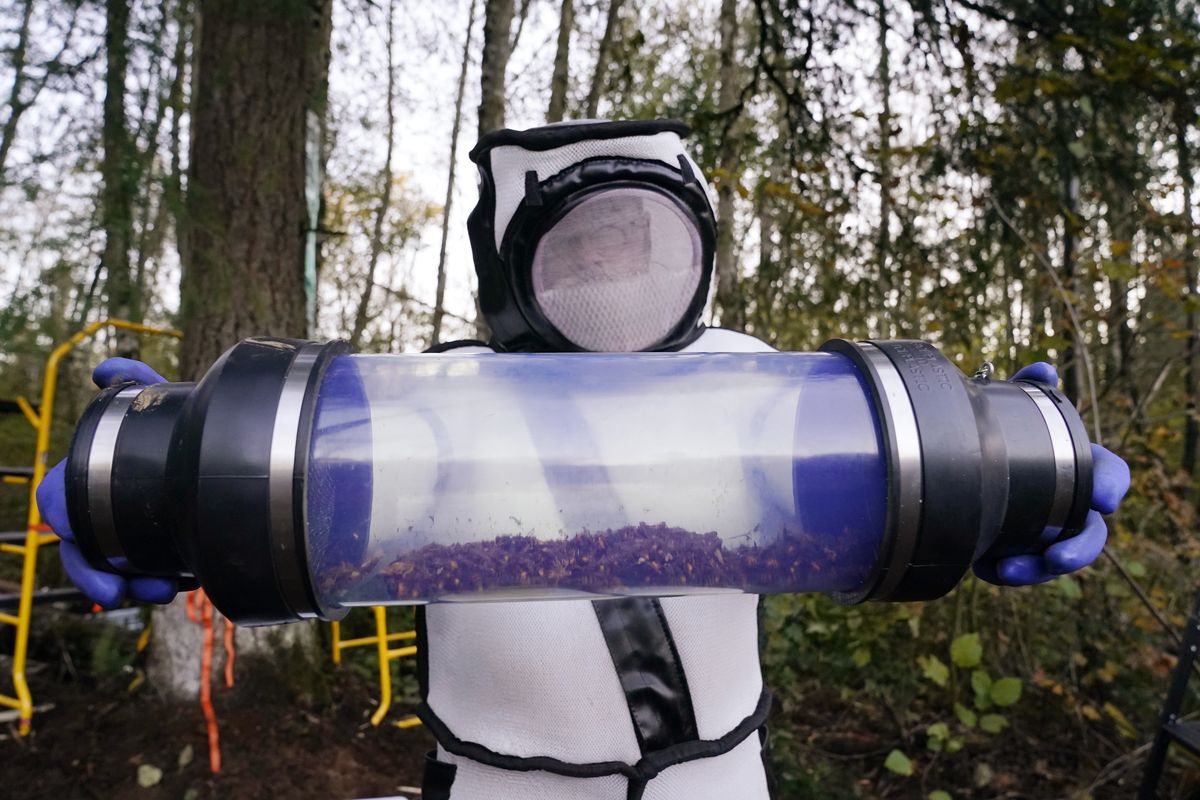500 Asian giant hornets found in nest eradicated last month near Blaine

State entomologists confirmed Tuesday they discovered more than 500 Asian giant hornets – including nearly 200 queens – in the nest they pulled from a tree last month.
The Washington State Department of Agriculture (WSDA) announced Oct. 23 that one of its teams had found the nest, the first in the United States, inside a tree near Blaine, Whatcom County. A team of WSDA workers set out to destroy it the following day in hopes of preventing the invasive insects from establishing a foothold here and decimating vulnerable bee populations.
They initially reported it had 98 hornets inside and that another 85 had been vacuumed into a special container. In a virtual news conference on Tuesday, WSDA managing entomologist Sven Spichiger revised those numbers way upward.
The team eradicating the nest found it had six layers of combs, which hold larvae as they develop, and 776 cells, each of which can hold a developing hornet. In total, the team found 190 larvae, 112 workers, nine drones – or male hornets – 76 queens and 108 “capped cells” with queens on the cusp of emerging inside, Spichiger said.
“To put that in perspective, there are nests in the native range that have upward of 4,000 cells and are capable of producing 700 to 800 queens,” Spichiger said.
He added, however, that when a “relatively small nest” like this one can pop out 200 queens, “it does give one a little bit of pause.”
“It seems like we got there just in the nick of time, as our original vacuum extraction seemed to only give us workers, and we only got queens four days later, after we cracked it open,” Spichiger said.
The WSDA has been keen to find Asian giant hornet nests since the insects’ presence in the United States was first detected in December, in the Blaine area, and another of the hornets was trapped near Birch Bay in July of this year.
At nearly 2 inches long, Asian giant hornets are the world’s largest hornets; they have a distinct orange face and dark, teardrop-shaped eyes. This intimidating appearance and the way they massacre entire beehives has earned them the moniker “murder hornets.” Only a few of the giant hornets can take out 30,000 healthy honeybees in a matter of hours.
They are an invasive species, but they seem to find the Pacific Northwest to be a hospitable new habitat, according to a recent study.
“This is an introduced species that is not supposed to be in the Pacific Northwest or in North America at all,” Spichiger said Tuesday. “They definitely compete with our native species, and as we were able to observe, they certainly can impact wasps and other stinging insects by basically eating wasp nests. And that’s going to have an impact on the ecosystem.”
He continued: “But most importantly for us, they are known predators of managed honeybees, which of course we use for pollination for many of our most important crops, and it’s just one more thing that the managed honeybees don’t need to deal with.”
Despite their scary nickname, “murder hornets” don’t necessarily pose more of a risk to humans than other stinging insects in the U.S., Spichiger noted last month.
While Spichiger said he believes other nests have yet to be found in the Pacific Northwest, he remains optimistic about limiting the spread and eradicating the population.
“WSDA’s Pest Program still hopes to eradicate Asian giant hornets from the Pacific Northwest in cooperation with our neighbors to the north in Canada,” the agency said in a Tuesday blog post. “The effort will take require international cooperation, research for better detection tools, and the continued work of vigilant observers from the public to prevent Asian giant hornets from gaining a permanent foothold here.”
The WSDA will continue trapping the hornets through at least Thanksgiving, Spichiger said Tuesday, though they’ll likely limit their search to worker hornets rather than tracking new queens. And even if none are found, the agency will continue trapping for at least three more years to confirm the hornets have left the region, WSDA said.